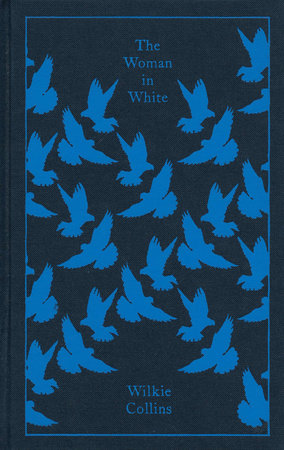There, in the middle of the broad, bright high-road--there, as if it had that moment sprung out of the earth or dropped from the haven--stood the figure of a solitary Woman, dressed from head to foot in white garments; her face bent in grave inquiry on mine, her hand pointing to the dark cloud over London, as I faced her.
I was too seriously startled by the suddenness with which this extraordinary apparition stood before me, in the dead of night and in that lonely place, to ask what she wanted. The strange woman spoke first.
'Is that the road to London?' she said.
The more things change, the more they stay the same: it is possible to trace in Wilkie Collins' The Woman in White the origins of all the hackish novels they sell on stands in airports, novels like The Da Vinci Code, with their outrageous secrets and puzzle box plots. These novels engage the reader by unfolding a central mystery, layer by layer, withheld at intervals, and the plot is subordinated to the contrivances needed to keep the mystery from unfolding all at once: a character with the required knowledge is killed, or perhaps is just a woman, who swoons or becomes gravely ill and too delirious to share what it is she knows. The dignifying effects of time give The Woman in White a sense of respectability; but it's hard not to imagine that "serious" readers turned their noses up at the coincidences, the exaggerated melodramatics. Popular novels have a way of congealing into "classics," but The Woman in White is probably best read as what it was to the Victorians: a silly, shaggy mystery story.
The plot is hard to describe without unpeeling too many of the mysterious layers. Walter Hartwright, meets a mysterious woman dressed in white, trying to find her way into the heart of London. The woman, who turns out to have escaped from a lunatic asylum, makes foreboding allusions to Limmeridge House in Cumberland, where Hartwright is about to take a position. At Limmeridge House, Hartwright falls in love with one of a pair of sisters, Laura Fairlie, but she has promised her now-dead father to marry a baronet named Sir Percival Glyde. But an anonymous letter, clearly sent by the "woman in white," suggests that Sir Percival is not to be trusted, and sure enough, once the two are marreid, Sir Percival--along with his flamboyant Italian co-conspirator Count Fosco, whose grandiloquent malice is the best thing in the book--sets to work conniving away Laura's fortune. Oh, did I mention that Laura and the woman in white look almost exactly alike?
The Woman in White is cleverly arranged in a series of first-person narratives that enable its mysteries to unfold piece by piece. The first and third sections are mostly narrated by Hartwright, who is conveniently shuffled off to Central America in the middle to allow Sir Percival and Count Fosco to work their dastardly plans on Laura and her sister Marian, who narrates most of the middle section. But other narratives crowd the margins, by servants, lawyers, and doctors, each of whom offers a piece of the larger puzzle.
Like I said, The Woman in White can seem very modern: it's not hard to imagine Dan Brown or, oh, Lee Child, or Janet Evanovich, or whoever those people are, from employing the same strategies. But it's a Victorian novel with Victorian anxieties, first and foremost the legal subordination of women to men. Laura marries because of her father's, then her uncle's wishes, and as Sir Percival's wife she is threatened primarily by his legal guardianship of her. Much of the drama of the book's middle revolves over whether Laura will or will not consent to give her signature to a legal document which Sir Percival hasn't allowed her to read. It's tempting to see the book as essentially feminist, critical as it is of Sir Percival's outsized power, but then again, Collins imports Hartwright again at the end--in his likeness as the husband that should have been--not to offer a radical version of women's liberation, but an encouragement for men to act as better shepherds.
There's the anxiety, too, around identity and rank: Laura, for instance, is captured and placed in the asylum under the name of Anne Catherick, the woman in white, because of their extreme likeness. (I'm no expert, but I think there's something here about the increasing reliance on law, on paperwork and signatures and things like that, to organize society: who are we when we rely on documents to affirm our identity?) This anxiety extends to questions of rank and status: what does it mean to be a baronet, anyway? Is it about money? (Sir Percival has none.) Is it about the way you are seen in the community? (Sir Percival is widely hated.) Again, is it about having your name written down in the social register? (And what of the marriage register that Hartwright suspects has forged Sir Percival's birthright?) For a Victorian, The Woman in White must have captured the drama that surrounded identity in a world that was rapidly industrializing and changing in all sorts of ways.
For a modern reader (me), it's just a lot of fun. There's swooning ladies, complicated identity-swapping, a burning church, clandestine letters, poisons, secret societies--The Woman in White is stuffed with so much of that stuff that even Dan Brown would think it's too much, I think. But maybe in 100 years or so we'll be reading his works with a different eye, too.


No comments:
Post a Comment